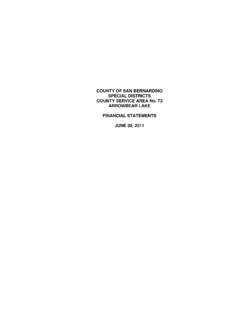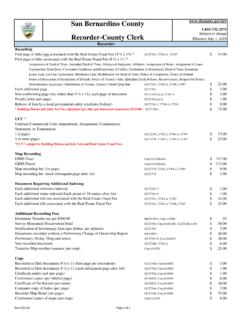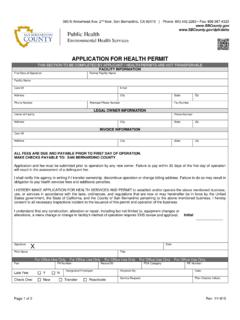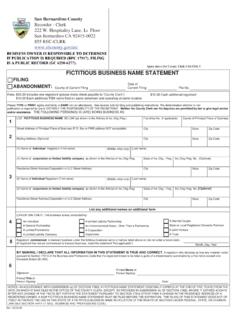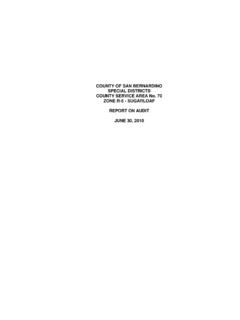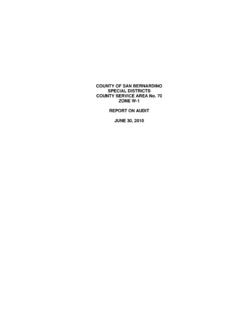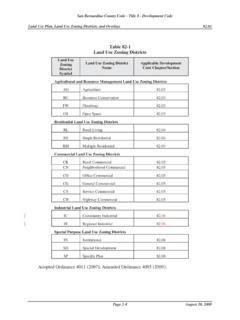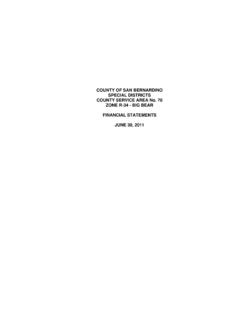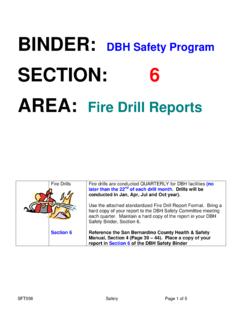Transcription of California Aboveground Petroleum Storage Act (APSA ...
1 California Aboveground Petroleum Storage ACT (APSA) FREQUENTLY ASKED QUESTIONS October 14, 2011 PROGRAM IMPLEMENTATION & COMPLIANCE Revision Date 10/14/2011 Page 2 Table of Contents I. General Administration .. Page 9 1. What is the relationship between APSA and the Federal Oil Spill Prevention Program? 2. Who is responsible for the implementation and administration of the APSA Program? 3. What are the release reporting requirements for Petroleum spills/releases at an APSA regulated tank facility? 4. Who is responsible for cleanup and abatement of releases from ASTs under APSA? II. Applicability .. Page 11 1. Who is subject to the requirements of APSA? 2. What is a tank facility? 3. What is Petroleum ? 4. Is biodiesel regulated under APSA? 5. Is propane, liquefied Petroleum gas, or liquefied natural gas regulated under APSA? 6. What tank facilities are conditionally exempt from the APSA requirement to prepare and implement an SPCC Plan?
2 7. Does the federal SPCC exemption for wastewater treatment systems/facilities apply to tank facilities regulated under APSA? 8. What tanks are excluded from the definition of Aboveground Storage tank? 9. Does any percentage of Petroleum oil content in a mixture (no matter how small) bring the mixture into APSA regulation as ' Petroleum ?' 10. Are hazardous waste tanks regulated under APSA? 11. Are businesses with Aboveground Storage tanks containing vegetable and/or animal oil, which are regulated under the federal SPCC plan rule, also included under the APSA program? 12. Are Aboveground Petroleum Storage tanks located on oil production facilities exempt from APSA? Revision Date 10/14/2011 Page 3 13. Does the phrase construction site as used in section (b) of the Health and Safety code include quarries and construction yards? 14. Construction activities are being performed on a portion of a manufacturing, commercial or maintenance facility with Aboveground tanks.
3 Is the entire facility considered a construction site? 15. Are federal facilities regulated under APSA? 16. Could circumstances exist that would cause an UST to be regulated under APSA? 17. What is the definition of a farm? 18. Does the term farm, as used in Health and Safety Code section (b) include dairies? 19. Is farming equipment, such as tractors, harvesters and other farming equipment subject to APSA/SPCC? 20. If a tank facility has multiple ASTs that are owned and operated by different persons, and if the total capacity of the tank(s) for each business is less than 1,320 gallons, but the total for all tanks at this single location exceeds 1,320 gallons, is each business subject to APSA? 21. If a single location houses multiple ASTs that are owned by different businesses but operated by the same business, and if the total capacity of the tank(s) owned by each business is less than 1,320 gallons, but the aggregate total for all tanks operated by the same operator at this single location exceeds 1,320 gallons, is each business subject to APSA?
4 22. The revised definition of facility in the November 2008 EPA amendments to the federal SPCC rule is far more flexible than the definition of tank facility under APSA. Can I follow the federal definition in determining whether I am regulated as a tank facility under APSA? 23. When a tank subject to the APSA requirements is owned and operated by two different entities, who do we charge for enforcement purposes, for example when they have not submitted a Storage statement or completed an SPCC Plan? Do we take enforcement against both the owner and the operator? 24. Is the term logging site defined? 25. Would sawmills and logging truck operations (yards and shops) fit the meaning of logging site? 26. What types of ASTs are included under the transportation-related tank facility s exclusion as referenced in HSC section (a)(6)? Revision Date 10/14/2011 Page 4 27. Are tank facilities regulated under APSA exempt from federal (EPA) regulation under federal SPCC rules?
5 28. Is there a retail exemption for APSA and/or SPCC? 29. Are materials like asphalt, seal coat, tack oil, etc. subject to APSA? 30. An APSA-regulated tank facility also conducts loading/unloading of Petroleum from APSA/SPCC-excluded transportation-related tanker trucks into APSA/SPCC-excluded underground Storage tanks, are the loading/unloading area and operation subject to APSA/SPCC? III. Aboveground Storage Tanks .. Page 27 1. What is a Storage tank? 2. What is the minimum tank size considered when calculating a tank facility s total Storage capacity? 3. What is Storage capacity? 4. How is a tank facility s Storage capacity determined? 5. Are Petroleum Storage tanks in vaults or basements considered to be Aboveground Storage tanks under APSA? 6. Is the following description of a tank considered an underground Storage tank or is it an Aboveground Storage tank? The tank s bottom rests on a single-pour concrete pedestal covered with a stainless steel sheet in such a manner that the tank bottom cannot be visually inspected.
6 The tank is located in an open-vaulted area where no portion of the tank is buried but more than 10 percent of the volume of the tank is located below the common surrounding soil level. 7. Are tanks or containers for hydraulic fluid considered to be ASTs and therefore subject to regulations? 8. Are containers with a minimum Storage capacity of 55 gallons of Petroleum (such as 55-gallon drums) regulated under APSA? 9. Are oil-filled operational equipment and/or oil-filled manufacturing equipment regulated under APSA? 10. Does the term equipment in HSC section (a)(4)(A) and (B) refer to singular or plural tanks? 11. If an AST is "empty," is that still an AST? Revision Date 10/14/2011 Page 5 12. Are there regulations for underground piping systems associated with ASTs? 13. How is underground piping outside the first flange or valve of the containment area associated with ASTs regulated? 14. Are there requirements for integrity testing of regulated piping?
7 If so, what is the leak detection threshold? 15. Since HSC section of the previous version of APSA has been repealed, are there still requirements to develop and implement a monitoring plan/program for ASTs? 16. Are below grade oil/water clarifiers regulated by APSA? 17. Does APSA or SPCC require ASTs to be elevated so that visual inspections of the bottom can be made? 18. Would a facility with portable totes that may be moved to different locations throughout the facility be required to amend their SPCC plan each time portable tanks/containers are moved? Do portable tanks require secondary containment? 19. Are self-propelled vehicles and equipment which have fuel tanks and hydraulic system reservoir tanks (such as self-propelled agricultural, construction, and excavation vehicles and self-propelled cranes) regulated as Aboveground tanks under APSA? 20. Is the UPA required to review and approve plans for modifications/repair to Aboveground Storage tanks?
8 IV. SPCC Plans .. Page 34 1. By what date must a tank facility that is subject to the Act have their SPCC Plan prepared and implemented? 2. Is it a requirement for tank facilities to submit, file or provide their SPCC Plans to the UPA, or for the UPA to approve the Plan? 3. Is it a requirement to have a California PE stamp the SPCC? 4. Who can sign or certify an SPCC Plan? 5. Can a facility use an SPCC Plan template? 6. Who reviews the SPCC Plan and how often is the SPCC Plan reviewed? 7. When must an SPCC Plan be amended by the facility operator? Revision Date 10/14/2011 Page 6 8. Under APSA does a qualified facility have to prepare an SPCC plan certified by a professional engineer to address the greater than 42,000-gallons of Petroleum stored in the USTs to meet the federal standards? 9. Can a facility prepare an SPCC plan that addresses multiple facilities or would they need to prepare an individual plan for each location?
9 V. APSA Fees .. Page 38 1. Are federal facilities required to pay the APSA fee set forth in section of the Health and Safety Code? 2. Are tank facilities with an aggregate total of Petroleum equal to 1,320 gallons but less than 10,000 gallon still subject to an UPA s APSA fees? 3. Is there a surcharge on this program for oversight? VI. Tank Facility Inspections .. Page 39 1. How often must the owner or operator perform visual inspections of their ASTs? 2. Are owners or operators of unattended tank facilities required to conduct daily inspections? 3. How often can a tank facility expect an UPA compliance inspection? 4. What type of activities can a tank facility expect to occur during an UPA compliance inspection? 5. How should the UPA inspector identifying various violations of SPCC Plan implementation, plan quality or content, etc., at a tank facility prepare the specific citation? 6. Are SPCC-exempt (as defined in APSA) facilities required to be inspected?
10 7. For the purposes of APSA, is an aggregate Storage of 10,000 gallons or more the trigger for triennial UPA APSA inspections? 8. What are the integrity testing requirements for ASTs? Are these different from the required frequent inspections? 9. How does a tank owner/operator conduct the required frequent inspections of the outside of the tank/container (reference CFR (c)(6)) on a double-walled tank? 10. Is there a specific type or style of spill kit required for facilities under APSA or SPCC? Revision Date 10/14/2011 Page 7 11. Are there specific tank labeling requirements under APSA or SPCC? 12. What is the meaning exactly of 24 hours of a 25 year storm event? How does one obtain this information? VII. Annual Tank Facility Statement .. Page 42 1. Who determines the format and content of the Annual Tank Facility Statement that the owner or operator of a regulated tank facility is required to submit to the UPA? 2.
